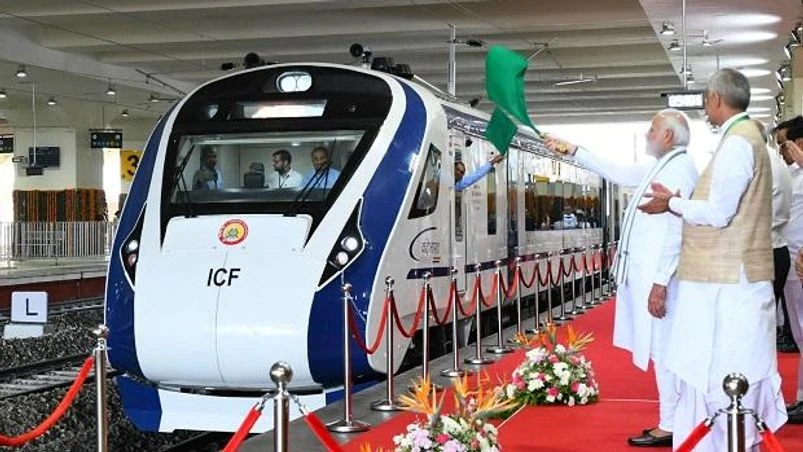 Is the Vande Bharat Express ahead of its time?
Is the Vande Bharat Express ahead of its time?
Prime Minister Narendra Modi flagged off the third Vande Bharat train on September 30. We ask today if our rail tracks and other infrastructure are ready for such a speed upgrade
Krishna Veera VanamaliAkash Podishetty New Delhi
)
Photo: @narendramodi (Twitter)
The Railways’ facelift
Indian Railways is up for a major facelift. Railway Minister Ashwini Vaishnav has said this week that peoplel will be able to enjoy the bullet train rides from 2026. He also said that the government will turn 199 railway stations into world-class stations, with all the modern facilities.
Vande Bharat Express
So, as part of this broader plan, the Railways is also rolling out semi high-speed Vande Bharat Express trains. These indigenously manufactured trains are also called Train 18. The first batch of Vande Bharat trains were rolled out in 2019.
And now, their upgraded version, Vande Bharat 2.0 has hit the rails. It can attain a maximum speed of 160 kmph due to faster acceleration and deceleration. The new Vande Bharat trains are also equipped with advanced state-of-the-art safety features, including an indigenously developed train collision avoidance system called KAVACH.
But, barely a week after the Vandhe Bharat Express between Gandhinagar and Mumbai was flagged off by Prime Minister Narendra Modi, the train required a facelift twice in two days due to cattle hits. It also faced a technical glitch on Delhi-Varanasi route on Saturday. It was a snag in a traction motor that jammed its wheels, causing a “flat tyre” – which refers to the damage to the roundness of the wheel. All the passengers had to be de-boarded and shifted to a Shatabdi Express mid-way.
The Railways, in response to cattle hit incidents, said the replaceable nose cover is designed to absorb the impact without transmitting it to the functional parts of the train, adding the part was sacrificial by design.
Also Read
Railway Minister Ashwini Vaishnaw provided a reality check. Interacting with students at an engineering college in Gujarat, he said collisions with cattle were inevitable until elevated rail tracks are in place.
More than 32,000 animals, including cattle, lions and leopards, have been killed on railway tracks between 2016 and 2018.
Given that cattle run over incidents by trains are a regular feature, the Indian Railways is planning to keep spares of Vande Bharat’s nose cones. The latest Vande Bharat trains are 38 tonnes lighter than its predecessor and hence faster. The nose of the train is made of fibre-reinforced plastic.
The Railways is also reportedly planning to install fences along the tracks on Vande Bharat routes to prevent accidents. Experts say fencing is necessary to avoid such accidents once train speeds cross 120-130 kmph, more so for semi high-speed rail as elevating tracks is a costly affair.
Most of the 508-km corridor of India’s first bullet train project between Mumbai and Ahmedabad will be elevated. With railway tracks passing through grazing lands, farms, and unplanned or illegal residential establishments, there are concerns over the practicality of fencing the entire network of tracks.
A former Railways official told Business Standard said that fencing would only work if alternatives were given to people for safer cross-track mobility, such as rail over/under bridges (ROBs/RUBs).
In FY23 so far, the Railways has eliminated 213 manned level crossings and built 250 rail over/under-bridges. It has said that there are no more unmanned crossings on its broad-gauge network.
Vinay Kumar Dutt, former additional member, Railway Board says infrastructure has kept pace with aspirations of Vande Bharat trains. Train speeds are dynamic and can be altered depending on the line stations. No new lines are required for Vande Bharat trains.
Experts say the infrastructure is already in place to keep up with aspirations of Vande Bharat. However, fencing upgradations are required for semi-high speed trains to avoid safety lapses.
More From This Section
Don't miss the most important news and views of the day. Get them on our Telegram channel
First Published: Oct 11 2022 | 9:31 AM IST

